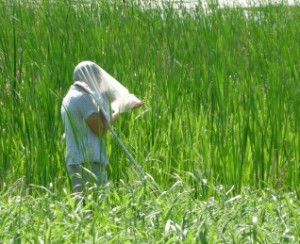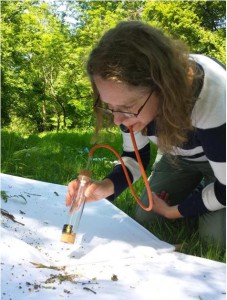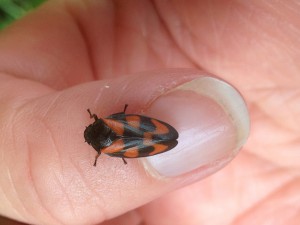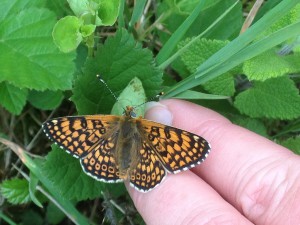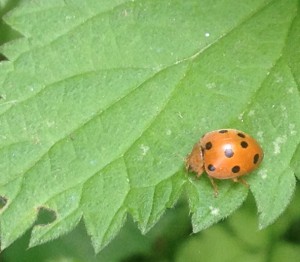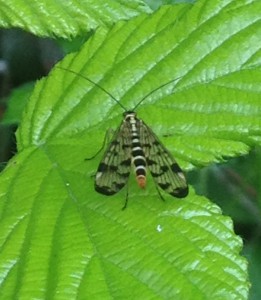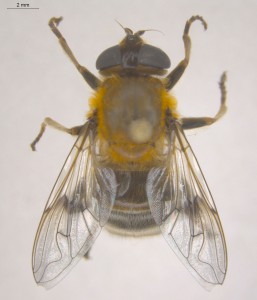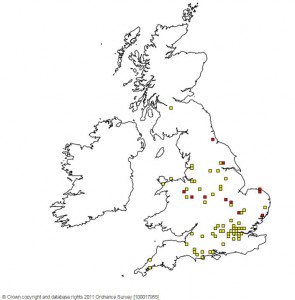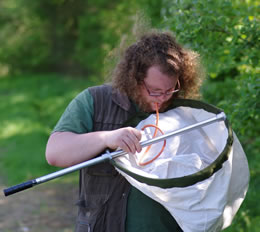
Early in the month is field work week – a regular slot that ensures time outside and the diary is mainly blocked out from infringements. This bit of “elbow space” has proven invaluable as I can legitimately say “Sorry but I am busy” and go off to the woods and practice some the skills I need to undergo metamorphosis into an entomologist. A range of sampling techniques is needed in order to fully appreciate the invertebrate fauna. The staple techniques for my work will be sweep netting, beating, and using aerial vane traps. Sweep nets are a great bit of kit and the sturdier the better. As the name suggests, one sweeps back and forth through the undergrowth in a fluid action to ensnare all unsuspecting insects. The trick however, is when you stop and want to keep everything you have swept in the net and then get it into a specimen pot. This is achieved by a flick of the wrist that effectually folds the net over the gaping mouth of the frame and invariably sticking your head inside and sucking up the contents with a pooter. Quite a scary proposition if you are not sure what’s lurking inside.
If however, if the species you are really interested in don’t fly about that quickly you can avoid looking like a slightly deranged ghost and go for the more genteel option ably demonstrated by Richard Comont below.
I am very lucky to be the proud owner of a lovely beating tray (thank you Esmée Fairbairn). This is a little like a flattened out, up turned square white umbrella. The name of the game here is to hold your tray underneath some tempting foliage and bash the branches with a stick. Great for stress busting but respect for the tree or shrub must be maintained and branches remain intact. The idea is just to dislodge any interesting beasties onto the tray below and not too much in the way of plant parts. The pooter comes in handy here too!
In the middle of May, I headed to the Poitou-Charentes region in south west France for a holiday and was impressed by the insect life over the channel. Many of the species spotted there can also be found in the UK (see pics below) but it just seems that they are more abundant, perhaps an indication of the warmer climate despite the landscape being fairly similar.
With feet back on British soil there was no time to take stock as less than 48hrs later and I was yet again at an airport. This time the destination was Helsinki, Finland or more precisely The Lammi Biological Station about a 90 minute drive north of the capital. This delightful place was the setting for the 2015 Deadwood Meeting and as this event deserves its own dedicated spot, I will cover this amazing experience in a separate post to be added very soon.
One final and rather exciting piece of news to share is that whilst I was away in Finland the rat tailed maggots from last months post emerged into their adult glory. The larvae turned out to be Mallota cimbiciformis, a bee mimic hoverfly. I had spotted 3 or 4 larvae in the rot hole material rescued from a cut tree in a log pile and not wanting to disturb them too much, had not dug around in the debris to explore. So, I figured maybe half a dozen or so were present but to my great surprise and delight more than 20 emerged.
Mallota cimbiciformis is a notable species and the adults are known to be quite elusive. This can often lead to under-recording and indeed there are only a dozen or so records for this lovely fly since 2000, none of which are in the Oxfordshire area (see NBN map below).
Half a dozen of the new adults were re-housed into a net cage and given cotton wool soaked with honey water. The “voucher” specimens have been deposited in the Hope Entomological Collections, and boost the numbers nicely as there were only 30 specimens previously, ranging in date from 1902 to 1989 (caught in a malaise trap in Somerset). The remaining adults were returned to the log in the wood along with a pre-release honey boost and fingers crossed for the next generation. What a great addition to the Wytham Woods list.
All the best, Ceri

